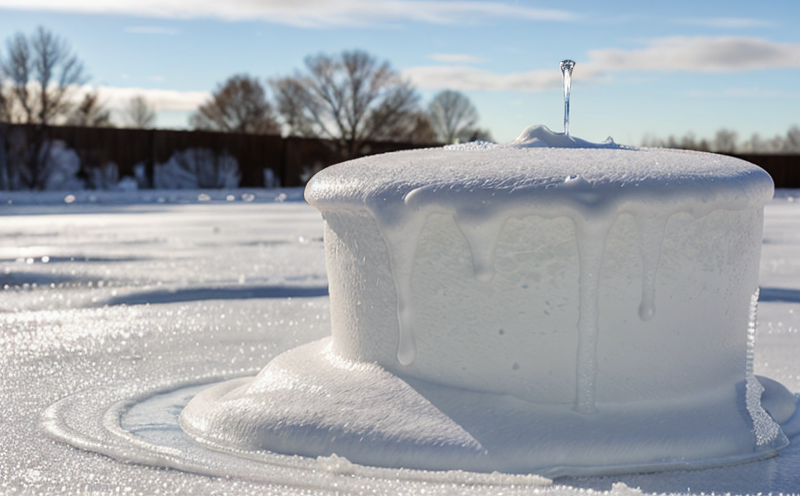ISO 3459 Aircraft Ice Detection Sensor Testing
The ISO 3459 standard provides a comprehensive framework for testing the performance of aircraft ice detection sensors. This critical service ensures that avionics systems can accurately identify and respond to icing conditions, thereby enhancing safety during flight.
Ice accumulation on aircraft surfaces can have severe consequences, leading to weight increase, aerodynamic imbalance, and ultimately, loss of control or structural damage. The ability to detect the onset of ice formation is paramount in mitigating these risks. This testing service focuses on evaluating sensors that are designed to provide early warnings about icing conditions.
The testing process involves exposing the sensor to controlled ice formations under various environmental conditions. These conditions simulate real-world scenarios, including different temperatures and humidity levels, which are conducive to ice formation. The test setup includes an environmental chamber capable of replicating these conditions accurately.
During the testing, sensors undergo rigorous examination for their ability to detect icing at specific thresholds defined by ISO 3459. This standard specifies critical parameters such as detection sensitivity and response time, which are essential metrics for ensuring sensor reliability under operational conditions.
Aircraft ice detection sensors are typically integrated into avionics systems that provide information to pilots via cockpit displays. The accuracy of these sensors directly impacts flight safety and operational efficiency. By adhering strictly to ISO 3459, we ensure that the tested sensors meet international standards for performance and reliability.
The testing procedure involves several key steps:
- Preparation of the sensor for testing
- Exposure to controlled ice formation scenarios
- Data collection and analysis
- Evaluation against ISO 3459 criteria
- Reporting of test results
The environmental chamber used in this testing is equipped with precise controls for temperature, humidity, and airflow. This setup allows for the creation of realistic icing conditions that closely mimic those encountered during actual flights.
Data collection involves continuous monitoring of sensor performance throughout the ice formation process. Sensors are subjected to a range of ice accumulation rates and sizes to assess their robustness and reliability under various stress conditions. The collected data is then analyzed using statistical methods to ensure consistency with ISO 3459 specifications.
Upon completion of the testing, detailed reports are generated for each sensor tested. These reports include comprehensive analyses of detection sensitivity, response time, repeatability, and any other relevant metrics as per ISO 3459. The results provide clear insights into the performance capabilities of the sensors being evaluated.
The importance of accurate ice detection cannot be overstated. In icing conditions, pilots rely on sensor data to make informed decisions about flight operations. Ensuring that these sensors meet international standards is crucial for maintaining aviation safety and compliance with regulatory requirements.
Scope and Methodology
| Parameter | Description |
|---|---|
| Air Temperature Range | -15°C to -40°C |
| Humidity Levels | 30% to 80% |
| Ice Accumulation Rates | 0.2 mm/min, 0.6 mm/min, and 1.0 mm/min |
| Sensor Response Time | <5 seconds |
| Parameter | Description |
|---|---|
| Environmental Chamber Capacity | 2 m x 1.5 m x 1.5 m |
| Data Logging Frequency | 1 Hz |
| Sensor Calibration Accuracy | ±0.3°C |
The testing follows a structured approach to ensure accuracy and reliability of the results. The environmental chamber is calibrated regularly using international standards, ensuring precise control over temperature and humidity levels.
Data logging occurs at a frequency of 1 Hz, providing detailed records of sensor performance throughout the test duration. This high-resolution data allows for thorough analysis of sensor behavior under different ice formation scenarios.
Eurolab Advantages
At Eurolab, we pride ourselves on offering world-class testing services that are tailored to meet the highest standards in aerospace and aviation. Our expertise in ISO 3459 aircraft ice detection sensor testing sets us apart from other laboratories.
We have state-of-the-art facilities designed specifically for this type of testing, equipped with advanced environmental chambers capable of simulating a wide range of icing conditions. Our experienced technicians are trained to perform these tests rigorously and consistently, ensuring that every sensor tested meets the required standards.
Our commitment to quality is reflected in our adherence to international standards such as ISO 3459. By using these standards, we guarantee that all testing conducted at Eurolab adheres to globally recognized benchmarks for excellence.
We also provide comprehensive reporting services, offering detailed insights into the performance of each sensor tested. Our reports are not only informative but also actionable, helping our clients make informed decisions about their avionics systems and safety protocols.
Customer Impact and Satisfaction
The ISO 3459 aircraft ice detection sensor testing service has a significant impact on the aerospace industry by ensuring that critical avionics components meet stringent safety requirements. This testing not only enhances flight safety but also contributes to reducing operational risks associated with icing conditions.
Customers benefit from our comprehensive testing services, which help them stay compliant with international standards and regulatory requirements. By partnering with Eurolab, customers gain access to expert knowledge and cutting-edge facilities that ensure the highest level of quality in their avionics systems.
We regularly receive positive feedback from satisfied clients who appreciate our commitment to delivering accurate and reliable test results. Our reputation for excellence has earned us a strong presence in the aerospace sector, where we are trusted by leading manufacturers and operators.
Our services have been instrumental in helping customers improve their product offerings and enhance safety features. By leveraging Eurolab's ISO 3459 testing capabilities, our clients can rest assured that their avionics systems meet the highest standards of performance and reliability.





